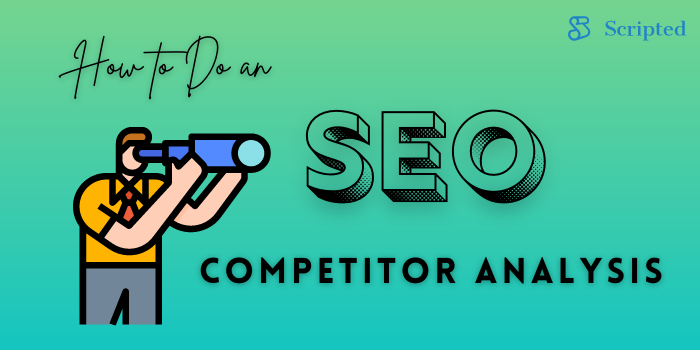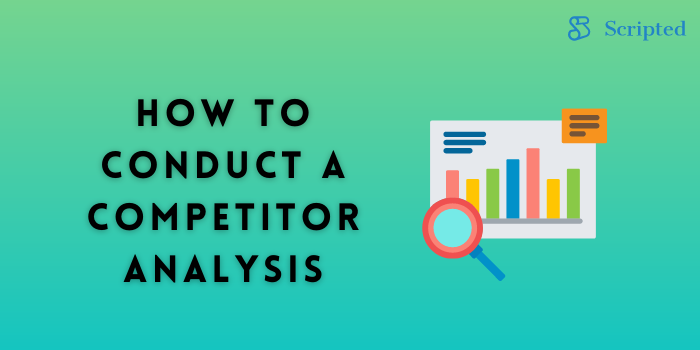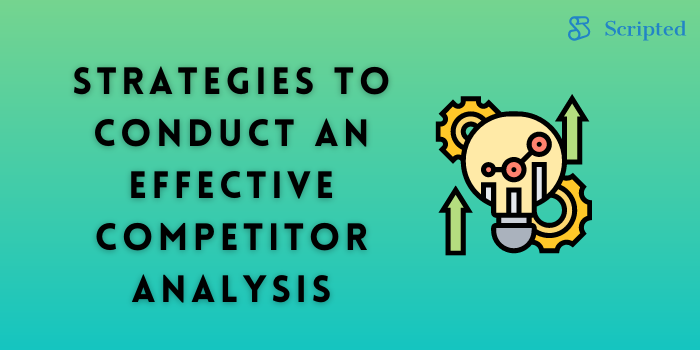- Blog Home
- Seo
- Jubilee Heutmaker
- How To Do An Seo Competitor Analysis
How to Do an SEO Competitor Analysis

If your goal is to get more website traffic, you're in the right place.
Although there are many tactics and strategies to implement, an SEO competitor analysis will be critical to your success. This powerful research strategy will not only help you get more traffic but also rank higher and improve conversion rates.
The goal is to discover opportunities that you would not have seen otherwise.
Ready to gain an edge over your competitors? Let's get started.
What Is an SEO Competitor Analysis?
Any successful, growing business keeps tabs on its competitors. Understanding these competitors' strengths and weaknesses is good business and could be the tactic you need to get ahead. If you don't strive to rise above your competitors, you'll be left behind — you can bet they're coming for your traffic.
SEO competitor analysis is the process by which you collect all the details you need to better understand your greatest rivals. The data you uncover will tell you what SEO tactics are working for them and which are not. Since you're in the same industry or niche, those tactics will also likely work for your ongoing goals. This analysis can also be rather telling in terms of your weaknesses.
When conducting a competitor analysis, you'll answer questions such as:
- Who are my greatest SEO competitors?
- What keywords should I target?
- What topics would be beneficial to cover?
- Where can I start building links that will improve my ranking?
- What steps do I need to take to beat my competitors?
Once you start researching the keywords, content, and links of your SEO competitors, you can begin to reverse-engineer the most successful tactics to use within your own SEO strategy. The concept here is to use information that already exists instead of playing a guessing game. Knowing what works will help you build a more competitive SEO strategy.
Why Does an SEO Competitor Analysis Matter?
The digital landscape is vast and constantly shifting. In such an environment, understanding where you stand in relation to your competitors is more than just a good strategy — It's a necessity. SEO competitor analysis shines a spotlight on this relationship.
At its core, the primary aim of competitor analysis is to extract valuable insights about your competitors, allowing you to refine and enhance your SEO game plan. It’s a proactive approach to discern what's working for others in your industry and how you can adapt those strategies, with a unique twist, to your benefit.
However, a word of caution is in order. Falling into the trap of directly copying competitors' content is a slippery slope. Not only do search engines, like Google, penalize duplicate content, but such actions can also erode your brand's unique voice and credibility in the eyes of your audience. That is why you should always create unique content.
Instead of replicating your competitors' content, use the data you discover to adjust the tactics you currently use to come up with novel ways to improve your own SEO strategy. A combination of human expertise and cutting-edge AI tools, as offered by Scripted, can take your analysis to the next level. Scripted, for instance, allows you to harness the power of its AI chatbot Scripted Copilot to identify content trends while its pool of subject matter experts ensures your content's authenticity and relevance.
Creating engaging, unique content will forever remain the gold standard. With the insights from a competitor analysis, you can fine-tune that content to better resonate with your audience and search engines. It offers a strategic blueprint, highlighting potential gaps in your current SEO approach. For example, there might be high-potential keywords or link-building opportunities that you haven't tapped into, but your competitors have. By integrating these into your strategy while still maintaining originality, you can achieve enhanced visibility and reach.
In essence, an SEO competitor analysis is not about mimicking or getting lost in the competition. It's about understanding the competitive landscape, finding your unique space within it, and leveraging insights to steer your SEO strategy toward success.
Unsure where to begin creating unique content after your analysis? Scripted can guide the way. Explore Scripted's Platform with a free 30-day trial.
How to Conduct a Competitor Analysis
Executing a thorough SEO competitor analysis is not as straightforward as following a checklist; it's more nuanced and tailored. While the essence of the process remains consistent, the specific methods and depths to which you delve can vary based on factors such as your company's size, the nature of your industry, the demographics of your target audience, and your overarching business objectives.
Nevertheless, foundational steps provide a framework for this exploration. To begin this process, you need to know who your competitors are.
Step One: Identify Your Competitors
Whether you've been in business for ten years or recently launched a startup company, the business landscape is always changing. With the rise of digital marketplaces and e-commerce platforms, it's essential to keep an updated list of competitors. Businesses open and close every day, which is why you need to stay mindful of those in your industry and even beyond.
You likely have a good idea of who your direct competitors are, having invested time monitoring their activities. You've probably already spent countless hours checking out their site, social accounts, and perhaps even their customer reviews or feedback sections. These competitors will certainly be included in your analysis. However, they won't be the only ones.
When it comes to SEO, competitors may not be in your industry at all. It's a broader spectrum: any page or site that's ranking for your target keywords is an SEO competitor. This means that even forums, blogs, or news articles can be potential competitors.
For instance, if you're managing marketing for an athletic clothing company, you might want to optimize your blog to rank for terms like "sports gear" or "basketball apparel." While the primary contenders using these keywords might be other sportswear brands, you could also be competing against authoritative sites such as TSN, BBC Sport, or even health and fitness bloggers.
To get a comprehensive competitor list, start by identifying your target keywords. Conduct thorough keyword research using various tools and methods. While the Google Keyword Planner is a robust tool, consider using platforms like SEMrush or Ahrefs to get a different perspective on keyword competitiveness and potential search volume.
Related Reading: A Step-by-Step Guide to Keyword Research
With your list of keywords at the ready, venture into Google and other search engines like Bing or DuckDuckGo. The pages and sites that emerge in the search results will form the crux of your competitors. Focus predominantly on the top 3-4 results, as they usually get the most traffic. Also, pay special attention to the site or page that occupies the "featured snippet" position. This elevated placement often garners significant attention and can provide insights into the type of content search engines deem valuable for specific queries.
Step Two: Analyze the Strengths and Weaknesses of Your Competitors
Next, you'll need to dive deeper into your competitors in terms of what they offer. Try to answer questions such as:
- What is their market share?
- What are the needs of their ideal customers?
- How do they distribute their products/services?
- How are they different? What is their USP?
- What does their sales process look like?
- Do they have a blog?
- Are they creating whitepapers or case studies?
- What advertising campaigns are they running?
As you answer these questions, you'll continue to uncover more and more valuable data.
In addition to the questions mentioned above, consider utilizing various tools for competitor analysis to gather comprehensive insights. These tools can include:
- Competitor analysis software: Invest in competitor analysis software like SEMrush, Ahrefs, or Moz to track your competitors' online performance, keyword rankings, and backlink profiles.
- Social media monitoring: Monitor your competitors' social media accounts and engagement metrics. Tools like Hootsuite or Buffer can help streamline this process.
- Web analytics: Examine your competitors' website traffic, user behavior, and conversion rates using tools like Google Analytics or similar platforms.
- SEO tools: Utilize SEO tools like Screaming Frog or Ubersuggest to analyze on-page SEO elements, meta tags, and keyword strategies employed by your competitors.
- Email marketing analysis: Study your competitors' email marketing campaigns using tools like Mailchimp or Constant Contact to understand their messaging and segmentation strategies.
- Competitor surveys: Conduct surveys among your target audience to gather feedback about your competitors. This can provide valuable insights into customer perceptions and preferences.
Beyond what's mentioned above, the following are some other key areas to consider when conducting competitor analysis:
Competitor Collaboration and Partnerships
In addition to gathering data on your competitors, it's also valuable to explore potential collaboration opportunities. Consider looking into whether your competitors have established partnerships or collaborations with other businesses in your industry. This can provide insights into their strategic alliances and areas of mutual interest. Tools like industry-specific forums and business directories can help identify these partnerships.
Market Trends and Emerging Competitors
Competitor analysis should not be confined to your current competitors. Stay vigilant about emerging players in your industry. Keep an eye on startups, new market entrants, or disruptors that might be gaining traction. Identify their unique value propositions and growth strategies. Monitoring industry news, attending relevant conferences, and subscribing to industry newsletters can help you stay informed about market trends and potential disruptors.
International Competitor Analysis
If your business operates in a global market or has aspirations to expand internationally, it's crucial to analyze competitors on a global scale. Consider tools that offer international competitor analysis capabilities. Assess how your competitors adapt their strategies in different regions and examine their success or challenges in penetrating diverse markets.
Benchmarking and Strategy Formulation
Use the data and insights you've gathered to benchmark your own performance against competitors. Identify gaps and areas where you can improve. Develop a strategic plan based on your competitor analysis, outlining how you can leverage your strengths and address weaknesses to gain a competitive advantage.
Continuous Monitoring and Adaptation
Competitor analysis is not a one-time task but an ongoing process. Markets evolve, and competitors adapt. Continuously monitor your competitors and update your analysis to reflect changes in their strategies, offerings, and market positions. Regularly review your own strategy to ensure it remains aligned with your findings.
Step Three: Conduct a Backlink Analysis
Content is critical, especially in terms of keywords. However, it's only one piece of the puzzle. To achieve a high ranking, you also need to build an impressive backlink profile. The best way to do this is to use a tool, such as the Link Explorer from Moz.com or the Ahrefs Backlink Checker, to analyze your competitors' backlinks. You may notice a pattern associated with the inbound links of your rivals. If they are ranking higher than you, it's beneficial to see how you differ.
In addition to utilizing the tools mentioned above, consider the following approaches to enhance your backlink analysis:
- Exploring Anchor Texts: When analyzing your competitors' backlinks, pay attention to the anchor texts used in those links. Understanding the anchor texts can provide insights into the keywords and topics most closely associated with their content. This information can help refine your own content and SEO strategy.
- Identifying High Authority Domains: Look for patterns in the domains that link to your competitors. Identify high-authority websites and authoritative publications that frequently reference your competitors' content. These sources could be potential targets for your backlink outreach efforts.
- Assessing Link Quality: Not all backlinks are created equal. Evaluate the quality of your competitors' backlinks. Are they coming from reputable sources, or are they low-quality, spammy websites? Tools like Google's PageRank and domain authority scores from Moz can help you assess link quality.
- Backlink Gap Analysis: Conduct a backlink gap analysis to identify the backlinks that your competitors have, but you do not. This can uncover opportunities to acquire valuable backlinks from sources relevant to your niche.
- Competitor Outreach: Consider reaching out to websites that link to your competitors. If your content offers additional value or a unique perspective, you may be able to convince these websites to link to your content as well.
- Monitoring Changes Over Time: Backlink profiles evolve, so it's important to monitor changes over time. Use tools that offer historical backlink data to track how your competitors' backlinks have grown or declined and adjust your strategy accordingly.
By expanding your backlink analysis with these considerations, you can gain a more comprehensive understanding of your competitors' link-building strategies. This information will enable you to refine your own backlink profile, improve your search engine rankings, and ultimately enhance your online visibility and authority within your industry.
Step Four: Analyze On-Page SEO Factors
The quality of the content your competitors publish matters. Go through each competitor's site, focusing on their blog, product descriptions, social media content, etc. Is the content engaging and valuable? Do your competitors publish lengthy, in-depth articles? How are they using keywords and optimizing their content for SEO?
In this step, it's crucial to examine not only the quality of your competitors' content but also the on-page SEO elements they employ. Take the time to assess their meta tags, header tags, URL structure, and keyword usage. Leveraging AI tools like Scripted's Page Analyzer & Recommendations will not only allow you to investigate your competitors' on-page SEO tactics but also make recommendations for improving your own website's content.
This thorough analysis may require additional time and effort, but it's essential to understand what sets your competitors apart from you in terms of on-page SEO. By identifying the specific on-page tactics they're using, you can gain valuable insights into how your content needs to be improved to enhance its search engine visibility and user engagement.
For top-notch content analysis and creation that matches SEO best practices, check out what Scripted has to offer. See how Scripted can enhance your SEO.
Strategies to Conduct an Effective Competitor Analysis
While the digital landscape continually evolves, certain strategies remain foundational to understanding your competition. Reflecting on the steps mentioned earlier, let's delve deeper into the core strategies available today and sprinkle in some additional insights.
- Keyword Gap Analysis — Beyond merely spotting keywords your competitors rank for, it's crucial to identify those with high potential but low competition. These are the gems that your competitors might have overlooked but could offer significant advantages to your SEO strategy. Moz's Keyword Explorer is a favorite for this, but other platforms like Ahrefs also provide similar capabilities.
- Competitor Content Analysis — Zeroing in on your competitors' top-performing content is essential. Identify what has earned them the most backlinks, shares, and engagement. Once you have this data, strive to create superior content. This doesn’t mean simply adding more words. You want to enrich your content with in-depth analysis, case studies, engaging visuals, or even interactive elements. While it's crucial to draw inspiration, always prioritize crafting unique and fresh content. Repurpose with a twist, ensuring you offer new insights, the latest stats, and value that captivates your readers.
- Link Gap Analysis — Backlinks form the backbone of a robust SEO strategy. Hence, it's imperative to understand which high-authority sites link to your competitors but overlook you. Comprehend the reasons behind this. It could be due to the quality of content, relationship-building, or even specific outreach campaigns. Tools like Link Explorer’s Link Intersect are handy for this meticulous analysis.
- Google SERP Analysis — Beyond the realm of keywords lies the nuanced understanding of searcher intent. Why does Google prioritize certain results over others for specific keywords? Dive deep into the search results to dissect the kind of content that satiates user queries. Tools like MozBar for Chrome and Scripted's Keyword Research Tool can give you a head start but don't shy away from manual analysis to truly understand the context.
Additional tools to consider:
- Alexa — While many associate it with simple traffic tracking, it offers a treasure trove of insights about audience demographics, site overlap, and more. If you have the Moz toolbar installed, it readily displays the Alexa rank, but exploring Alexa's dashboard provides a richer context.
- SE Ranking — Beyond simple rank tracking, SE Ranking provides insights into competitors' PPC campaigns, website changes, and even their social media strategies.
- Monitor Backlinks — As the name suggests, it's a comprehensive tool that notifies you whenever your competitors earn or lose backlinks. This can provide timely insights for your outreach campaigns.
- SpyFu — Apart from giving you a peek into your competitors' keywords, SpyFu can enlighten you about their AdWords campaigns, allowing you to formulate a more informed PPC strategy.
Remember, the key is not just to gather data but to convert that data into actionable insights. Analyze, strategize, and iterate for consistent growth.
How Scripted Can Help
In the ever-evolving world of digital content, standing out and maintaining consistent quality can be challenging. That's where Scripted steps in. Whether you're refining your existing blog posts or embarking on a new content venture for social media to fortify your SEO game, Scripted has got you covered.
At its core, Scripted offers a vast reservoir of highly vetted writers, ensuring you gain access to the industry's top talent without hassle. The process is straightforward:
- Become a member
- Post your job on the platform
- Opt for Scripted's unique SmartMatch feature, which intelligently pairs your project with the most suitable writer, or hand-select a writer based on your preference
- Receive your first draft within days
- Accept or request revisions, tailoring the content to perfection
Every aspect of hiring and content creation is streamlined on the platform for a hassle-free experience.
But Scripted's allure doesn’t just halt at its elite writers. It extends to a suite of AI tools and features that don't just provide content — they architect a content strategy. Here's how:
- Scripted Analytics: Once connected to your Google Analytics account, you receive a succinct summary of pivotal data points, ensuring you always have a pulse on your content's performance.
- Blog Ideas: Let AI steer your content direction with pre-crafted article proposals, allowing you to select topics that resonate with your audience.
- Smart Content Brief: Simplify the briefing process. Input your topic, and the AI crafts a detailed content brief that pinpoints goals, the target audience, and other vital parameters.
- The Strategy Chatbot: A GPT-4 powered gem, this chatbot is your personal content strategy consultant. Gain insights on optimal channels, formats, and topics to guide your content execution.
- Headline Generator Tool: Craft attention-grabbing headlines using AI insights, ensuring your content gets the clicks it deserves.
- Keyword Research Tool: Bolster your SEO approach. By analyzing search metrics and trends, this tool recommends high-potential keywords, amplifying your search visibility.
- Scripted for Teams: More than just a platform, it's an ecosystem for businesses to seamlessly collaborate, access a gamut of pre-screened writers, and harness AI tools like SmartMatch, Analytics, and more.
- Scripted Copilot Chatbot: Scripted's Scripted Copilot Chatbot is your friendly AI helper, adept in content creation, SEO strategizing, and analytics. Scripted Copilot can help you with keyword research, topic ideation, content optimization, and much more. With AI's efficiency at its core, Scripted Copilot can be your secret weapon in creating top-performing content.
Scripted's subject matter experts (SMEs) ensure a perfect match for your industry needs. So whether you're rehiring your favorite writer or seeking fresh perspectives, Scripted facilitates it all.
Remember, in the race to outpace competitors, it's not just about quantity but also the quality of your content. With Scripted's novel blend of AI-driven insights and SMEs, you harness both the efficiency of technology and the nuance of the human touch.
This unique combination ensures your content is not only optimized but also resonates authentically with your target audience. Accepting only the top 2% of applicants means Scripted's team is dedicated to quality. Whether it's blog posts, whitepapers, press releases, newsletters, or any other type of written content, Scripted offers the ideal fusion of AI and expertise to elevate your content marketing strategy.
Ready to get started? Schedule a demo today!
Published by Jubilee Heutmaker on Thursday, November 23, 2023 in Seo, Content Strategy, Seo, Seo Tools.





